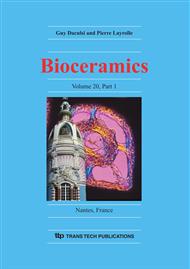p.805
p.809
p.813
p.817
p.821
p.825
p.829
p.833
p.837
Non-Destructive Stress Evaluation on Ce-TZP/Al2O3 Nanocomposite-VINTAGE ZR T-Glass Systems by Confocal Fluorescence Piezo-Spectroscopy
Abstract:
In the area of dental treatment for crown and dental implants, ceramics restoration is becoming popular due to both aesthetic needs and release of metallic allergy. However, for the restoration of defected tooth, ceramics materials with higher reliability than that of conventional glass or alumina have been required, thus raising expectations for zirconia ceramics. Since residual stress play a significant role in the reliability of dental implants, in this paper, a non-destructive assessment of residual stress is presented for a zirconia-substrate/VINTAGE ZR T-Glass system using confocal fluorescence microprobe spectroscopy.
Info:
Periodical:
Pages:
821-824
Citation:
Online since:
November 2007
Authors:
Keywords:
Price:
Сopyright:
© 2008 Trans Tech Publications Ltd. All Rights Reserved
Share:
Citation:


